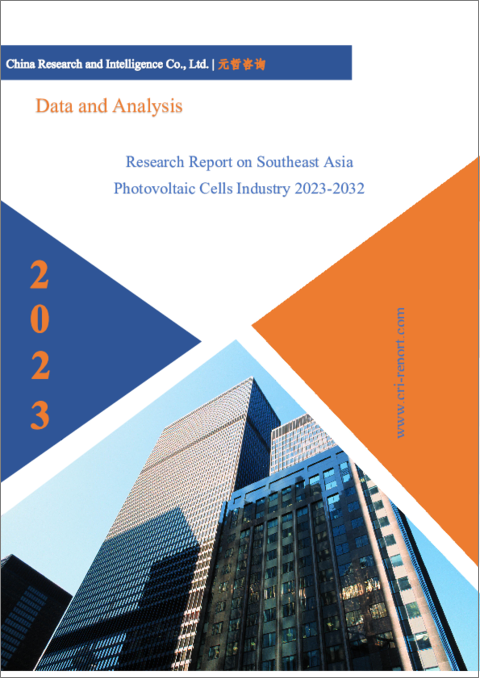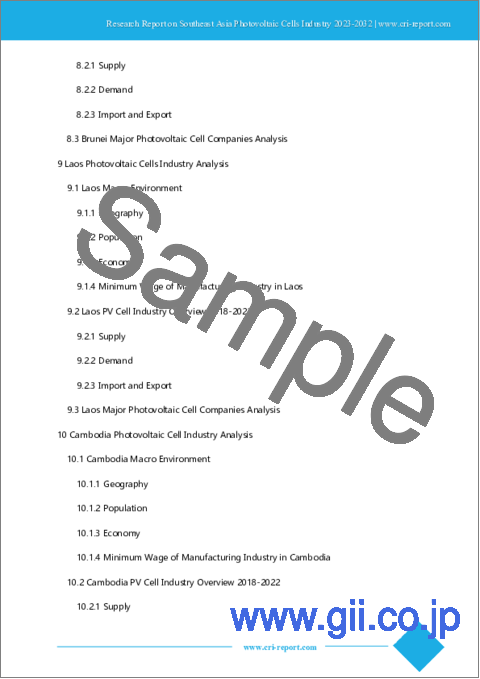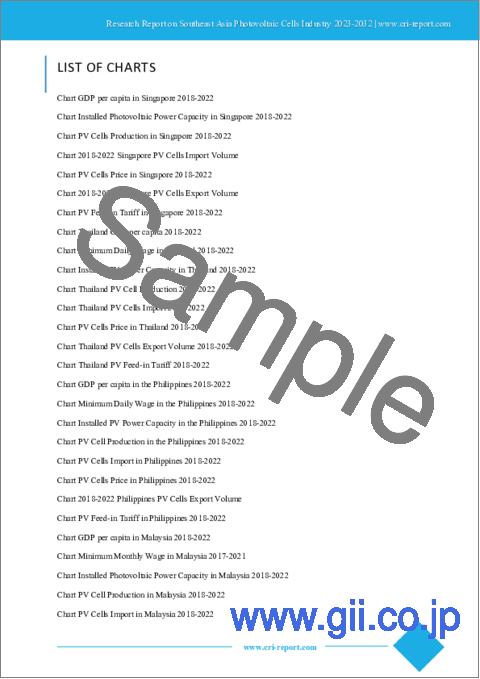|
|
市場調査レポート
商品コード
1174069
東南アジアの太陽電池産業:2023-2032年Research Report on Southeast Asia Photovoltaic Cells Industry 2023-2032 |
||||||
| 東南アジアの太陽電池産業:2023-2032年 |
|
出版日: 2022年12月16日
発行: China Research and Intelligence
ページ情報: 英文 80 Pages
納期: 即日から翌営業日
|
- 全表示
- 概要
- 目次
東南アジア諸国における太陽電池産業の発展には大きな差があり、各国の太陽光発電の設備容量にも大きな差があります。2021年末には総人口が6億人を超える東南アジアは、全体の経済成長率が世界平均を上回り、今後の世界経済の成長を牽引する重要な地域の一つです。
東南アジア地域の対米PVモジュール輸出は2023年から2024年にかけて高い伸びを示すと予想されています。全体として、東南アジア諸国の太陽電池産業は近年発展しており、特にベトナムやタイなどの新興国市場が急速な経済成長を遂げていることが、太陽電池産業の発展を後押ししています。
当レポートでは、東南アジアの主要10カ国における太陽電池産業を調査し、マクロ環境、需給および輸出入規模の推移・予測、主要企業、市場成長への各種影響因子の分析などをまとめています。
目次
第1章 シンガポールの太陽電池産業の分析
- マクロ環境
- 地域
- 人口
- 経済
- 製造業の最低賃金
- 太陽電池産業の概要:2018-2022年
- 供給
- 需要
- 輸出入
- 主な太陽電池企業の分析
第2章 タイの太陽電池産業の分析
- マクロ環境
- 地域
- 人口
- 経済
- 製造業の最低賃金
- 太陽電池産業の概要:2018-2022年
- 供給
- 需要
- 輸出入
- 主な太陽電池企業の分析
第3章 フィリピンの太陽電池産業の分析
- マクロ環境
- 地域
- 人口
- 経済
- 製造業の最低賃金
- 太陽電池産業の概要:2018-2022年
- 供給
- 需要
- 輸出入
- 主な太陽電池企業の分析
第4章 マレーシア太陽電池産業分析
- マレーシアのマクロ環境
- 地域
- 人口
- 経済
- マレーシアの製造業の最低賃金
- マレーシアの太陽電池産業の概要2018-2022
- 供給
- 需要
- 輸出入
- マレーシアの主要な太陽電池会社の分析
第5章 インドネシアの太陽電池産業の分析
- マクロ環境
- 地域
- 人口
- 経済
- 製造業の最低賃金
- 太陽電池産業の概要:2018-2022年
- 供給
- 需要
- 輸出入
- 主な太陽電池企業の分析
第6章 ベトナムの太陽電池産業の分析
- マクロ環境
- 地域
- 人口
- 経済
- 製造業の最低賃金
- 太陽電池産業の概要:2018-2022年
- 供給
- 需要
- 輸出入
- 主な太陽電池企業の分析
第7章 ミャンマーの太陽電池産業の分析
- マクロ環境
- 地域
- 人口
- 経済
- 製造業の最低賃金
- 太陽電池産業の概要:2018-2022年
- 供給
- 需要
- 輸出入
- 主な太陽電池企業の分析
第8章 ブルネイの太陽電池産業の分析
- マクロ環境
- 地域
- 人口
- 経済
- 製造業の最低賃金
- 太陽電池産業の概要:2018-2022年
- 供給
- 需要
- 輸出入
- 主な太陽電池企業の分析
第9章 ラオスの太陽電池産業の分析
- マクロ環境
- 地域
- 人口
- 経済
- 製造業の最低賃金
- 太陽電池産業の概要:2018-2022年
- 供給
- 需要
- 輸出入
- 主な太陽電池企業の分析
第10章 カンボジアの太陽電池産業の分析
- マクロ環境
- 地域
- 人口
- 経済
- 製造業の最低賃金
- 太陽電池産業の概要:2018-2022年
- 供給
- 需要
- 輸出入
- 主な太陽電池企業の分析
第11章 東南アジアの太陽電池産業の見通し:2023~2032年
- 産業の発展への影響要因の分析
- 有利な要因
- 不利な要因
- 東南アジアの太陽電池産業の成長予測
- 東南アジアの太陽電池産業における中国企業の展開
- 太陽電池産業に対するCOVID-19の影響
The development of PV cell industry in Southeast Asian countries varies greatly, and the installed capacity of PV power generation in each country also varies greatly. For the time being, foreign enterprises establish PV cell component factories in Southeast Asian countries, mainly for export to developed countries, but the local PV power generation market in Southeast Asia is also developing rapidly.
Southeast Asia in this report includes 10 countries: Singapore, Thailand, Philippines, Malaysia, Indonesia, Vietnam, Myanmar, Brunei, Laos and Cambodia. With a total population of over 600 million by the end of 2021, Southeast Asia has an overall economic growth rate higher than the global average and is one of the key drivers of future global economic growth.
According to CRI's analysis, the economic levels of the 10 Southeast Asian countries vary greatly, with Singapore being the only developed country with a per capita GDP of about US$73,000 in 2021. While Myanmar and Cambodia will have a GDP per capita of less than US$2,000 in 2021. The population and minimum wage levels also vary greatly from country to country, with Brunei, which has the smallest population, having a total population of less than 500,000 people in 2021, and Indonesia, which has the largest population, having a population of about 275 million people in 2021. The most economically advanced countries in Southeast Asia do not have a legal minimum wage, with the actual minimum wage exceeding US$400 per month (for foreign maids), while the lowest minimum wage level in Myanmar is only about US$93 per month.
In March 2022, U.S. PV manufacturer AuxinSolar and others petitioned the U.S. Department of Commerce to take an anti-circumvention investigation of PV products from four Southeast Asian countries; the U.S. Department of Commerce subsequently conducted an investigation, and recently, the release of the preliminary findings of the investigation has been extended from August 2022 to November 2022. On July 1, 2022, the U.S. Department of Commerce published draft regulations implementing Notice No. 10414 and invited public comment.
On September 16, 2022, the U.S. government published a "Final Rule" implementing the Presidential Proclamation. The Final Rule was issued in response to a countervailing investigation filed by AuxinSolar in March 2022. The "Final Rule" confirms that imports of PV cells and modules from four Southeast Asian countries will be exempt from anti-dumping or countervailing duties from June 6, 2022 through June 6, 2024. Under this provision, no cash deposit will be charged on PV cells and modules exported from the four Southeast Asian countries until the deadline (June 6, 2024).
"Final Rule requires installation of modules within 180 days of the cut-off date: To prevent stockpiling by downstream manufacturers, the Final Rule requires modules purchased before the cut-off date (June 6, 2024) to be used or installed in the U.S. by 180 days after the cut-off date. "The Final Rule indicates that in the event of an affirmative determination of countervailing action, no antidumping or countervailing duties will be imposed on cells and modules that enter the United States or are withdrawn from storage for use in Southeast Asia prior to the cut-off date or before the use cut-off date.
CRI expects Southeast Asia's PV module exports to the U.S. to see high growth in 2023-2024.
Overall, the PV cell industry in Southeast Asian countries has been developing in recent years, especially the rise of emerging markets such as Vietnam and Thailand, with rapid economic growth, which has driven the development of the PV cell industry.
According to CRI forecast, the PV cell industry in Southeast Asia will continue to grow in 2023-2032. On the one hand, the cheap labor and land cost attracts a large number of foreign investors to shift their production capacity to Southeast Asia, and the scale of foreign trade expands, promoting the development of its PV cell industry. On the other hand, economic growth in Southeast Asia and increased demand for domestic passenger and freight transport will also promote the development of the PV cell industry.
Topics covered:
- Southeast Asia Photovoltaic Cell Industry Status and Major Sources in 2018-2022
- What is the Impact of COVID-19 on Southeast Asia Photovoltaic Cell Industry?
- Which Companies are the Major Players in Southeast Asia Photovoltaic Cell Industry Market and What are their Competitive Benchmarks?
- Key Drivers and Market Opportunities in Southeast Asia Photovoltaic Cell Industry
- What are the Key Drivers, Challenges, and Opportunities for Southeast Asia Photovoltaic Cell Industry during 2023-2032?
- What is the Expected Revenue of Southeast Asia Photovoltaic Cell Industry during 2023-2032?
- What are the Strategies Adopted by the Key Players in the Market to Increase Their Market Share in the Industry?
- What are the Competitive Advantages of the Major Players in Southeast Asia Photovoltaic Cell Industry Market?
- Which Segment of Southeast Asia Photovoltaic Cell Industry is Expected to Dominate the Market in 2032?
- What are the Major Adverse Factors Facing Southeast Asia Photovoltaic Cell Industry?
Table of Contents
1 Singapore Photovoltaic Cell Industry Analysis
- 1.1 Singapore Macro Environment
- 1.1.1 Geography
- 1.1.2 Population
- 1.1.3 Economy
- 1.1.4 Singapore Manufacturing Minimum Wage
- 1.2 Singapore PV Cell Industry Overview 2018-2022
- 1.2.1 Supply
- 1.2.2 Demand
- 1.2.3 Import and Export
- 1.3 Singapore Major Photovoltaic Cell Companies Analysis
2 Thailand Photovoltaic Cell Industry Analysis
- 2.1 Thailand Macro Environment
- 2.1.1 Geography
- 2.1.2 Population
- 2.1.3 Economy
- 2.1.4 Thailand Manufacturing Minimum Wage
- 2.2 Thailand PV Cell Industry Overview 2018-2022
- 2.2.1 Supply
- 2.2.2 Demand
- 2.2.3 Import and Export
- 2.3 Analysis of Major Photovoltaic Cell Companies in the Philippines
3 Analysis of Photovoltaic Cell Industry in the Philippines
- 3.1 Macro Environment of the Philippines
- 3.1.1 Geography
- 3.1.2 Population
- 3.1.3 Economy
- 3.1.4 Philippines Manufacturing Minimum Wage
- 3.2 Philippines Photovoltaic Cell Industry Overview 2018-2022
- 3.2.1 Supply
- 3.2.2 Demand
- 3.2.3 Import and Export
- 3.3 Analysis of Major Photovoltaic Cell Companies in the Philippines
4 Malaysia Photovoltaic Cell Industry Analysis
- 4.1 Malaysia Macro Environment
- 4.1.1 Geography
- 4.1.2 Population
- 4.1.3 Economy
- 4.1.4 Malaysia Manufacturing Minimum Wage
- 4.2 Malaysia PV Cell Industry Overview 2018-2022
- 4.2.1 Supply
- 4.2.2 Demand
- 4.2.3 Import and Export
- 4.3 Malaysia Major Photovoltaic Cell Companies Analysis
5 Indonesia Photovoltaic Cell Industry Analysis
- 5.1 Indonesia Macro Environment
- 5.1.1 Geography
- 5.1.2 Population
- 5.1.3 Economy
- 5.1.4 Indonesia Manufacturing Minimum Wage
- 5.2 Indonesia PV Cell Industry Overview 2018-2022
- 5.2.1 Supply
- 5.2.2 Demand
- 5.2.3 Import and Export
- 5.3 Indonesia Major Photovoltaic Cell Companies Analysis
6 Vietnam Photovoltaic Cell Industry Analysis
- 6.1 Vietnam Macro Environment
- 6.1.1 Geography
- 6.1.2 Population
- 6.1.3 Economy
- 6.1.4 Vietnam Manufacturing Minimum Wage
- 6.2 Vietnam PV Cell Industry Overview 2018-2022
- 6.2.1 Supply
- 6.2.2 Demand
- 6.2.3 Import and Export
- 6.3 Vietnam Major PV Cell Companies Analysis
7 Myanmar Photovoltaic Cell Industry Analysis
- 7.1 Myanmar Macro Environment
- 7.1.1 Geography
- 7.1.2 Population
- 7.1.3 Economy
- 7.1.4 Myanmar Manufacturing Minimum Wage
- 7.2 Myanmar PV Cell Industry Overview 2018-2022
- 7.2.1 Supply
- 7.2.2 Demand
- 7.2.3 Import and Export
- 7.3 Myanmar Major Photovoltaic Cell Companies Analysis
8 Brunei Photovoltaic Cell Industry Analysis
- 8.1 Brunei Macro Environment
- 8.1.1 Geography
- 8.1.2 Population
- 8.1.3 Economy
- 8.1.4 Brunei Manufacturing Minimum Wage
- 8.2 Brunei PV Cells Industry Overview 2018-2022
- 8.2.1 Supply
- 8.2.2 Demand
- 8.2.3 Import and Export
- 8.3 Brunei Major Photovoltaic Cell Companies Analysis
9 Laos Photovoltaic Cells Industry Analysis
- 9.1 Laos Macro Environment
- 9.1.1 Geography
- 9.1.2 Population
- 9.1.3 Economy
- 9.1.4 Minimum Wage of Manufacturing Industry in Laos
- 9.2 Laos PV Cell Industry Overview 2018-2022
- 9.2.1 Supply
- 9.2.2 Demand
- 9.2.3 Import and Export
- 9.3 Laos Major Photovoltaic Cell Companies Analysis
10 Cambodia Photovoltaic Cell Industry Analysis
- 10.1 Cambodia Macro Environment
- 10.1.1 Geography
- 10.1.2 Population
- 10.1.3 Economy
- 10.1.4 Minimum Wage of Manufacturing Industry in Cambodia
- 10.2 Cambodia PV Cell Industry Overview 2018-2022
- 10.2.1 Supply
- 10.2.2 Demand
- 10.2.3 Import and Export
- 10.3 Analysis of Major Photovoltaic Cell Companies in Cambodia
11 Southeast Asia PV Cells Industry Outlook 2023-2032
- 11.1 Southeast Asia Photovoltaic Cell Industry Development Influencing Factors Analysis
- 11.1.1 Favorable Factors
- 11.1.2 Disadvantageous Factors
- 11.2 Southeast Asia PV Cells Industry Development Forecast 2023-2032
- 11.3 Layout of Chinese Companies in Southeast Asia Photovoltaic Cell Industry
- 11.4 Impact of COVID -19 Epidemic on PV Cell Industry




